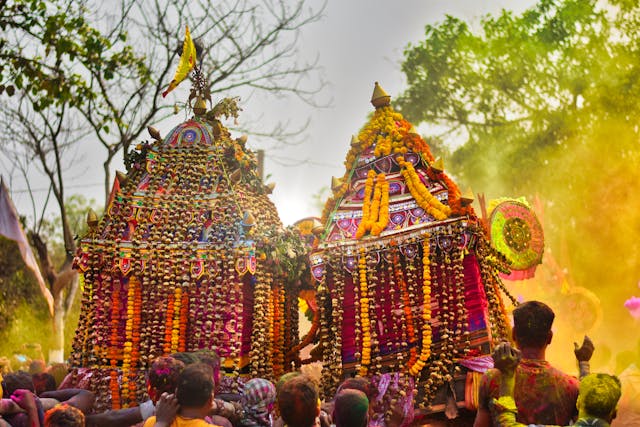The Sacred Craft: Unraveling the Chariot Making Process for Puri's Rath Yatra
Discover the sacred, intricate process behind the magnificent Puri Jagannath chariots. Learn how skilled artisans, guided by ancient traditions, craft these colossal vehicles for the annual Rath Yatra.
PURI
As the scorching Odisha summer gives way to the monsoon's embrace, an ancient hum begins to resonate in Puri. It’s the sound of saws biting into wood, chisels shaping intricate designs, and the collective devotion of countless artisans preparing for one of the grandest spectacles on Earth: the Puri Rath Yatra. At the heart of this festival are the colossal chariots of Lord Jagannath, Balabhadra, and Devi Subhadra not just vehicles, but living embodiments of faith, meticulously crafted anew each year.
So, how exactly are these magnificent structures brought to life? It's a fascinating blend of tradition, scripture, and unparalleled skill passed down through generations.
The Divine Blueprint: Rooted in Tradition
The process isn't a modern-day construction project. It's guided by ancient scriptures and a fixed set of rules. The dimensions, the type of wood, the number of wheels, the colors, and even the specific deities adorning each chariot are all preordained. This unwavering adherence to tradition ensures the sanctity and authenticity of the Rath Yatra year after year.
The Sacred Timber: A Divine Selection
The journey begins months in advance with the selection of the wood. Primarily, specific varieties of timber like Phasi, Dhau, and Asana are chosen from designated forests, particularly Nayagarh. These trees are not just felled; their selection involves ritualistic prayers and offerings. The timber is then transported to Puri, where it is seasoned and prepared for the intricate work ahead.
The Carpenters of the Lord: Biswakarmas at Work
The primary architects of the chariots are the 'Biswakarmas' or traditional carpenters, who belong to a specific lineage and have inherited this sacred duty. Their knowledge isn't from textbooks but from centuries of oral tradition and practical experience. Under the leadership of the 'Maharana' (chief carpenter), they work tirelessly.
Key stages of the construction and relevant dates:
Akshaya Tritiya (Typically in April/May, this year on April 30, 2025): The Auspicious Beginning. This day marks the formal commencement of the chariot construction. After ritualistic prayers and receiving the 'Agyan Mala' (divine permission garland) from the deities, the first logs of wood are brought to the 'Rath Khala' (chariot-making yard) on the Grand Road. A special ceremony called "Ratha Katha Anukula" takes place, where skilled Vishwakarma Maharana Sevayats perform puja, tie a sacred saree to the logs, and symbolically cut them with a golden axe. This also marks the beginning of the 42-day 'Chandan Jatra', a ceremonial bathing of the symbolic idols to provide respite from the summer heat. The construction begins with the chariot of Lord Balabhadra (Taladhwaja), followed by Lord Jagannath's (Nandighosa), and then Devi Subhadra's (Darpadalana). The goal is to complete the chariots in approximately 58 days from Akshaya Tritiya.
Chassis and Wheels: This is where the sheer scale of the chariots becomes evident. Lord Jagannath's chariot, Nandighosa, has 16 wheels; Lord Balabhadra's Taladhwaja has 14; and Devi Subhadra's Darpadalana has 12. Each wheel is a massive, solid wooden disk. The central axle and the foundational structure are built first, providing the sturdy base for the towering superstructures.
Bhaunri Festival (19th day of construction, around May 20, 2025): A Key Milestone. This festival marks a significant progress point in the chariot construction. On this day, the ceremonial fitting of the 26 wheels (for all three chariots) with wooden axles takes place after special pujas, signifying that the base structures are well underway.
Platform and Pillars: As the base takes shape, the platform for the deities is constructed, followed by the numerous pillars and crossbeams that form the framework of the chariot. Each joint is a testament to precision, often using traditional joinery techniques without nails or screws.
The 'Gupta' (Secret) Chambers: Each chariot has a 'gupta' or secret chamber, a small enclosure where certain rituals are performed during the Yatra.
Deity Panels and Sculptures: This is where the chariots truly come alive. Skilled sculptors carve intricate panels depicting various deities, mythological figures, and traditional motifs. Each chariot has specific guardian deities ('Parswa Devatas') associated with it, which are meticulously carved and affixed.
Colors and Adornments: Finally, the chariots are painted in vibrant, traditional colors. Nandighosa is predominantly yellow and red, Taladhwaja is green and red, and Darpadalana is black and red. These colors are derived from natural pigments. Elaborate fabric canopies, banners, and decorative elements made from traditional materials are then added, giving the chariots their majestic appearance.
The Role of Other Artisans: A Community Effort
While the Biswakarmas are the primary builders, the chariot making is a true community effort, involving various other specialized artisans:
Rupakaras (Sculptors): Responsible for the intricate carvings of deities and decorative motifs.
Ojha Maharana (Blacksmiths): Forge the necessary metal fittings, including the axles and pins.
Chitrakaras (Painters): Apply the vibrant colors and intricate designs.
Darzis (Tailors): Stitch the elaborate fabric canopies and decorative coverings.
Rath Bhogis (Helpers): Provide assistance in various tasks.
A Ritualistic Endeavor
The entire process is steeped in religious rituals. From the first cut of the wood to the final embellishments, prayers and Vedic hymns accompany each stage. The artisans observe strict codes of conduct, often fasting or refraining from certain activities, recognizing the sacred nature of their work.
Leading up to the Yatra: Key Pre-Festival Dates
Snana Purnima (Full moon day of Jyestha, around June 11, 2025): The Grand Bath. While not directly part of the chariot construction, Snana Purnima is a crucial precursor. On this day, the deities are brought out of the temple for a ceremonial bath with 108 pots of sacred water. After this elaborate bathing, they are believed to fall ill and enter a 15-day period of seclusion known as 'Anasara Kala'. During this time, the deities are not visible to the public, and only specific servitors care for them with herbal remedies.
Netrotsava (Day before Rath Yatra): Reappearance of the Deities. After the Anasara period, on the day before the Rath Yatra, the deities reappear for public viewing during Netrotsava (or Naba Yauvanotsava). Their eyes are repainted, signifying their full recovery and readiness for the grand journey.
Rath Yatra (Typically in June/July, this year on June 27, 2025): The Grand Festival. Finally, on the second day of the bright fortnight of Ashadha (Ashadha Shukla Dwitiya), the magnificent chariots are ready, and the deities embark on their annual journey to the Gundicha Temple, pulled by millions of devotees.
More Than Just Wood and Wheels
When the Rath Yatra finally commences, and the massive chariots begin their slow, majestic journey down the Bada Danda, they are more than just wooden structures. They are a culmination of centuries of tradition, the unparalleled skill of dedicated artisans, and the profound devotion of millions. Each chisel mark, each brushstroke, each joint tells a story of faith, resilience, and a timeless connection to the divine.
The chariot making process for Puri's Rath Yatra is not merely carpentry; it is a living ritual, a vibrant testament to India's rich spiritual and artistic heritage, and a profound experience for all who witness it.


